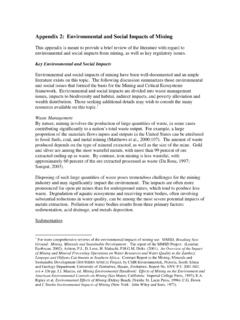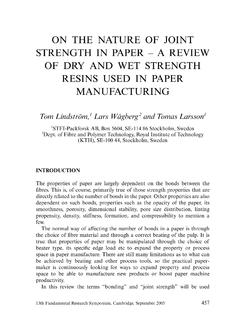Transcription of A Retrospective Review of Shale Gas Development in the ...
1 1616 P St. NW Washington, DC 20036 202-328-5000 April 2013 RFF DP 13-12 A Retrospective Review of Shale Gas Development in the United States What Led to the Boom? Zhongmin Wang and Alan Krupnick DISCUSSION PAPER 2013 Resources for the Future. All rights reserved. No portion of this paper may be reproduced without permission of the authors. Discussion papers are research materials circulated by their authors for purposes of information and discussion. They have not necessarily undergone formal peer Review . A Retrospective Review of Shale Gas Development in the United States: What Led to the Boom? Zhongmin Wang and Alan Krupnick Abstract This is the first academic paper that reviews the economic, policy, and technology history of Shale gas Development in the United States.
2 The primary objective of the paper is to answer the question of what led to the Shale gas boom in the United States to help inform stakeholders in those countries that are attempting to develop their own Shale gas resources. This paper is also a case study of the incentive, process, and impact of technology innovations and the role of government in promoting technology innovations in the energy industry. Our Review finds that government policy, private entrepreneurship, technology innovations, private land and mineral rights ownership, high natural gas prices in the 2000s, and a number of other factors all made important contributions to the Shale gas boom.
3 Key Words: Shale gas, policy, research and Development , technology, hydraulic fracturing, horizontal drilling JEL Classification Numbers: Q4, O3, L71 Contents 1. Introduction .. 1 2. Government Policies .. 6 What Led to the Government Policies on Unconventional Natural Gas? .. 6 Incentive Pricing and Tax Credit .. 8 R&D 9 3. The Development History of the Barnett Shale Play .. 15 Why Did Mitchell Energy Develop the Barnett Play? .. 16 How Did Technologies and Know-How Evolve at Mitchell Energy? .. 19 Did Environmental Issues Affect Mitchell Energy? .. 24 What External Help Did Mitchell Energy Obtain?
4 24 How Did the Mitchell Devon Merger Accelerate Development ? .. 27 4. High Natural Gas Prices in the 2000s .. 28 5. Other Contributing Factors .. 29 Geology .. 29 Land/Mineral Ownership .. 30 Market Structure .. 30 Water Availability .. 31 Natural Gas Pipeline Infrastructure .. 31 Capital Market .. 31 Other Factors .. 32 6. Concluding Remarks .. 32 References .. 35 Resources for the Future Wang and Krupnick 1 A Retrospective Review of Shale Gas Development in the United States: What Led to the Boom? 1. Introduction Shale gas experienced an extraordinary boom in the United States in the past decade. Figure 1 shows the annual and projected production of natural gas, by type, in the United States from 1990 to 2020.
5 Figure 2 shows the same thing for Shale gas in the United States from 1979 to 2020. Shale gas accounted for only percent of total US natural gas production in 2000, but this percentage had jumped to percent by 2005 and to an astonishing percent by 2010. This remarkable growth of Shale gas production in the United States has spurred increasing interest in exploring Shale resources in other areas of the world. A number of countries, including China,1 Mexico,2 Argentina,3 Poland,4 India,5 and Australia6 are considering or are in the process of developing their own Shale gas Naturally, scholars, policymakers, and many other stakeholders who are interested in the Development of Shale gas outside of the United States are asking about the important factors for successfully developing Shale gas resources.
6 One way to shed light on this issue is to learn from the US experience. While it is difficult to know definitively the necessary or sufficient conditions for stoking a Shale gas boom, a historical Review of the US experience can at least inform the conditions that helped. In this paper, we We are grateful to Jan Mares for helpful discussions and comments and to Yushuang Wang for excellent research assistance. We thank Energy Foundation s China Sustainable Energy Program for financial assistance. Wang: Krupnick: 1 China has launched two rounds of Shale gas block auctions, and the Chinese government issued, in March 2012, the Shale Gas Development Plan 2011 2015, which seeks to reach an annual Shale gas production of Bcm by 2015.
7 2 According to International Energy Agency (IEA) (2012, ), Mexico is keen to exploit Shale gas resources to boost the country s flagging output of unconventional oil and gas. 3 See Gonzalez and Orihuela (2012). 4 See Kenarov (2012). 5 See Stern (2012). 6 See IEA (2012) for Shale gas Development in Australia, the sixth-largest Shale gas resource country (Energy Information Administration 2011). 7 Some other countries ( , France) have banned the use of hydraulic fracturing to drill Shale gas. Resources for the Future Wang and Krupnick 2 provide the first academic Review of the economic, policy, and technology history of Shale gas Development to answer the question of what led to the Shale gas boom in the United States.
8 8 Figure 1. Annual US Natural Gas Production and Projected Production by Gas Type, 1990 2020 Source: Energy Information Administration 2013. Figure 2. Annual Shale Gas Production and Projected Production, 1979 2020 Sources: Energy Information Administration 2013 and Curtis 2009. 8 Some newspaper articles and consultancy reports, when discussing whether a country other than the US can develop Shale gas successfully, often mention in passing what factors contributed to the Shale gas boom in the US The longest discussion of the history of Shale gas Development in the media is a report by the Breakthrough Institute (Trembath et al 2012), which focuses on government s role in the Development of hydraulic fracturing in Shale .
9 510152025 Annual Production (Tcf)1990200020102020 Conventional gasTight gasCoal bed methaneShale gas0200040006000800010000 Annual Production (Bcf)19801990200020102020 EnCanaEIAEIA ProjectionResources for the Future Wang and Krupnick 3 For a real boom to occur in the private sector, high profitability, or at least the expectation of future high profitability, is a necessary ingredient. Our Review suggests that a number of factors converged in the early 2000s to make it profitable for firms to produce large quantities of Shale gas, but the most important factor was technology innovation, which took a long time to develop and ultimately made it cost-effective to produce Shale gas.
10 The main question we address in this paper is then, where did the technology innovations come from? Our Review finds that some of the key technology innovations resulted from government research and Development (R&D) programs and private entrepreneurship that aimed to develop unconventional natural gas ( , Shale gas, coalbed methane, and tight gas), but some of the key technologies ( , horizontal drilling and three-dimensional [3-D] seismic imaging) were largely developed by the oil industry to explore and produce oil instead of unconventional natural gas. The seed of the Shale gas boom was planted in the late 1970s when the US government decided to fund R&D programs and provide tax credits (and incentive pricing) for developing unconventional natural gas in response to the severe natural gas shortage at the time.
















